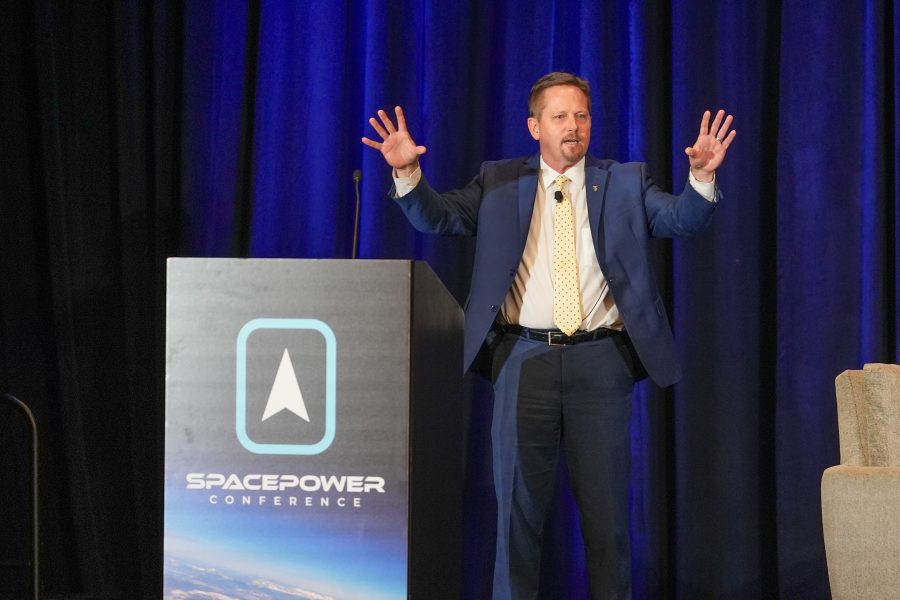ORLANDO, Fla.—The Space Rapid Capabilities Office, charged with quickly delivering cutting-edge, often-classified technologies for the Space Force, has made key progress in its push to modernize the aging system used to control U.S. government satellites, its director revealed last week.
Additionally, the secretive organization deployed “threat awareness sensors” in geosynchronous orbit this year that have already yielded intelligence on foreign capabilities, director Kelly Hammett told reporters at the Space Force Association’s Spacepower Conference.
Compared to the Space Force’s other two acquisition arms—the Space Development Agency and Space Systems Command—the Space RCO reveals very little about what it does. But Hammett did say that his organization’s size and portfolio continue to grow as they take on new projects and ramp up work on others.
Perhaps the most high-profile program for which the office is responsible is the Satellite Communications Augmentation Resource (SCAR), which will provide desperately needed upgrades to the Satellite Control Network (SCN)
SCN, composed of 19 antennas stationed around the world, from Diego Garcia Island in the Indian Ocean to the village of Oakhanger in southern England to Schriever Space Force Base, Colo., is used to track a satellite’s location, collect its health and status reports, and send signals to control its subsystems such as power supply, antennas and mechanical and thermal control.

But the antennas are old—Hammett noted that they are technically the second-oldest active weapons system in the Pentagon, after the B-52 bomber—and can only maintain contact with one satellite at a time—an increasingly untenable situation given the growth in the number of satellites in orbit.
SCAR will boost SCN with electronically steerable phased array antennas that can connect with multiple satellites in a time, expanding communications capacity ten-fold, according to the SpRCO. The office awarded a $1.4 billion contract to BlueHalo in May 2022, and Hammett told reporters in Orlando that in August 2023, the program completed a “one-meter demo,” clearing the way for full-scale radars to be produced.
The first radar is “on track” to be delivered in March 2025, Hammett added, but the SpRCO’s work hasn’t slowed while it waits.
“We are actually right now working very hard to figure out how to deliver the SCAR system, how to modernize the SCN, and to put together that integrated roadmap across the Space Force to modernize,” Hammett said.
In particular, the office has worked with other Space Force organizations to finalize the first location for a SCAR antenna, Hammett said, though he could not say where that would be.
“The modifications to the infrastructure at that location are underway,” Hammett said. “So they’ll be ready for us when we bring the first unit in 15 months versus, there’s a big gap because we haven’t worked all the details and we deliver the first unit and then it sits there or in a vendor facility somewhere. We don’t want that to happen. We want these things to get out there to be fielded and to be employed in time.”
Getting SCAR in place could be particularly important for the Space Force given the service’s increased interest in so-called “dynamic space operations,” which involves satellites maneuvering within and between orbits to conduct both defensive and offensive operations.
Right now, most satellites’ movement is defined by “station keeping,” or ensuring they stay in place in orbit. More extensive maneuvers will require more robust command and control, and that C2 has to “actually get out to antennas and tell the satellite, ‘You move here then, and you move here then,” Hammett noted. “And this all has to be done in near real-time.”
The Space RCO is also working on a program called Rapid Resilient Command and Control (R2C2) that will provide the software necessary for such control, Hammett added, with the goal of delivering working software in around three months for demonstration projects.
Also in 2023, the RCO had its first satellite launch in January. At the time, the Space Force described two of the three payloads on the launch as being for “enhanced situational awareness,” but little else was revealed about their purpose or results.
Hammett declined to offer many details about the payloads, but he did say they completed testing and checkout after launch in roughly 60 days.
“They’ve been flying around the GEO belt collecting data,” Hammett added. “And we have learned a lot of interesting data that I can’t go into the details, but I can say that has been shared with the intelligence community, it is changing the intelligence estimate on certain foreign capabilities.”
Now, the Space RCO is working with the rest of the Space Force to proliferate those sensors “to the rest of the enterprise,” Hammett said.
